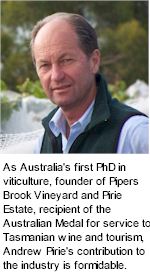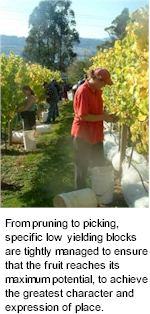


The Tamar Valley is situated in the north of Tasmania at a latitude of around 41-42° south. Approximately the same length as the Cote d'Or in Burgundy (90km) and with a similar cool, humid climate, vineyards occupy favoured N/NE facing sites predominantly along the west bank of the river. Chardonnay, Riesling, Sauvignon Blanc, Pinot Gris and Gewurztraminer are all grown here, producing fresh, extremely elegant whites. But for red wines, Pinot Noir is king. From the bright cherry and raspberry scented wines from Kayena in the Lower Tamar, to the heady truffle and black cherry aromas from the Upper Tamar vineyards at Relbia and White Hills, the variety of styles from this small region prove that the French do not have a monopoly on terroir.

From pruning to picking, specific low yielding blocks are tightly managed to ensure that the fruit reaches its maximum potential. In the winery, small parcels are individually nurtured in order to achieve the greatest character and expression of place. As part of their traditional styling, a significant contribution to the evolution of these wines is provided by bottle age and therefore, these wines will not reach their full potential until some years after release.
Every now and then, whether through the vagueries of vineyard or winery, one of the parcels will raise itself above the crowd and show truly outstanding qualities. When this happens, (always providing that in doing so, the Estate wines are not compromised in any way,) the wine will be bottled seperately. Often, although not always, these wines require greater time in both winery and cellar and will be released at a later date.
Surely one of the best views of any winery in the world, the winemaking heart of Pirie has always been at Rosevears Estate on the West Tamar. Quality is paramount and, although small, the winery can boast computer controlled heating and cooling on all tanks, a range of red fermenters, from traditional small open vats to a state-of-the-art rotating vinimatic, plus a well-equiped lab. With tank sizes down to 500 litres, the ability to give individual attention to small parcels of wine is essential, not only for the estate wines, but also for the number of small local growers whose wines are made under contract.

The estate's South label is about producing fresh, aromatic wines to complement modern food styles, using the finesse of northern Tasmanian fruit. The combination of a truly cool climate and summer rainfall, features which we share with northern France and New Zealand, make Tasmania particularly well suited to the production of these early-drinking wine styles.
Glenwood vineyard at Relbia is a NE facing 85ha property approximately 10km south of Launceston and 3km east of the airport where the North Esk River cuts through short, rolling hills on it’s way to feed the River Tamar. Pirie Tasmania draws fruit only from selected blocks, predominantly Pinot Noir. Protected both from significant maritime effects and the dominant influence of the Tamar itself, Relbia’s maximum elevation of 140m results in cooler maximum and colder minimum temperatures than in the Tamar Valley north of Launceston. White Hills vineyard is a high, steeply sloping 84ha property approximately 10km south of Launceston and 2km east of Relbia. Multiple aspects make it suitable for a number of varieties, including some Pinot and Chardonnay for sparkling. Like Relbia, it is protected both from significant maritime effects and the dominant influence of the River Tamar. Higher altitude (up to 170m) and greater exposure result in even cooler temperatures. The summit can be vulnerable to frost in some years.
As Australia's first PhD in viticulture, founder of Pipers Brook Vineyard (1973-2002) and more recently Pirie Estate and South labels (est 2004,) and recipient of the Australian Medal for his services to Tasmanian wine and tourism (2001,) Andrew Pirie's contribution to the industry is indisputable, as is Tasmania's position as a jewel in the crown of Australian wine.
